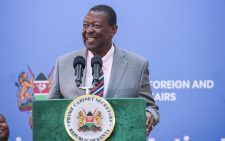Africa banking on financing in climate crisis adaptation

Financing for climate change adaptation and mitigation has become the most critical need for vulnerable developing countries in Africa and across the small island states.
Climate finance and the development of Nationally Determined Contributions (NDCs), as stipulated in the Paris Agreement, are currently the dominant issues in the global climate crisis. NDCs are the embodiment of a country’s efforts to reduce emissions and adapt to the impacts of climate change.
NDCs are aligned with National Action Plans (NAPs), a comprehensive document outlining countries strategies and actions to address climate change. NAPs include mitigation efforts to reduce greenhouse gas (GHG) emissions, and adaptation measures to manage the impacts of climate change across various sectors such as energy, agriculture and infrastructure.
Finance, technology, and capacity-building are critical enablers for reaching the goals of the Paris Agreement, the legally-binding treaty adopted by 196 United Nations members on 12 December 2015, which entered into force in November 2016.
Its overarching goal is to hold “the increase in the global average temperature to well below 2 degrees Celsius above pre-industrial levels” and pursue efforts “to limit the temperature increase to 1.5 degrees Celsius above pre-industrial levels.
Crossing the 1.5 degrees Celsius threshold risks unleashing far more severe climate change impacts, including more frequent and severe droughts, heatwaves and rainfall, according to the UN’s Intergovernmental Panel on Climate Change (IPCC),
Africa requires adequate and predictable means of implementation to maximise the opportunities provided by climate change. The cost of climate change solutions is estimated to reach US$4.5 trillion by 2030, according to the African Development Bank (AfDB).
Climate finance was the hottest issue during last November’s UN Climate Change Conference (COP29) in Baku, Azerbaijan, as developing countries took wealthy, fossil fuel-producing nations to task over their failure to fulfil long-standing climate finance pledges.
UN Secretary General António Guterres made a strong call-to-action at Baku on the need for a new climate finance goal to help developing countries combat flash flooding, drought, wildfires and other natural shocks made worse by human activity.
“Failure is not an option,” he warned, emphasising that the result of inaction could be catastrophic.
Eventually the developing and developed countries reached a compromise for US$300 billion a year in climate finance after fractious talks and tough negotiations.
Developing nations agreed to the deal rather than let the acrimonious talks collapse as that would have left them in a more desperate position and jeopardised their climate goals. They felt the amount offered was inadequate as developing countries continue to bear the burden of global warming caused by the biggest emitters from wealthy nations.
Citing the growing climate stress they continue to experience, representatives of the developing countries had demanded US$1.3 trillion dollars but had to climb down to the new post-2025 climate finance goal after the turbulent talks.
Rich nations agreed to channel US$300 billion a year by 2035 for developing countries’ resilience to climate change impacts by taking the lead in providing money and mobilising private sector investment. This will be part of a wider effort to scale up financing to reach the US$1.3 trillion target from all public and private sources.
Developing countries were unanimous that the US$300 billion was too low as it fell far short of the US$1.3 trillion they need to cope with climate change. The deal enraged African nations led by Kenya, Malawi and Uganda, which are disproportionately affected by the impacts of climate change it did little to cause.
New roadmap
Ali Mohamed, Kenya’s Special Envoy for Climate Change who is also the chairman of the African Group of Negotiators, on behalf of 50 African nations, had said the amount was “totally inadequate and would lead to unacceptable loss of life in Africa and around the world.”
In compromising on the climate finance goal, the “Baku to Belem, Brazil COP30 Roadmap to $1.3 trillion”, was agreed between the developing and wealthy nations in an effort to look for additional resources to drive low-carbon, climate-resilient development and to support the rollout of developed countries’ plans for cutting emissions and adapting to climate change.
The roadmap is being developed this year ahead of the climate summit in Brazil, and was put forward by the African Group (chaired by Ali Mohamed), Barbados, Colombia, Honduras and Panama in Baku.
The UN’s Green Climate Fund (GCF) is considering borrowing money from banks and other investors to meet a goal set by governments at COP29. This will increase spending by a group of funds that support developing countries, reports the UK-based Climate Home News.
Under pressure from the small island nations and the least developed countries in Baku, all governments agreed to “pursue efforts to at least triple annual outflows” between 2022 and 2030 from UN climate funds like the GCF – the largest multilateral climate fund. With climate finance from wealthy governments faltering, GCF’s director of strategy, policy and innovation,
Alain Beauvillard, told Climate Home that the fund was considering tapping capital markets to help meet this goal.
He said the GCF has an “ambitious” goal to manage US$50 billion by 2030, set in 2023 by its Executive Director Mafalda Duarte, but foreign aid budgets are “not growing fast, some are falling and basically Ukraine is taking the greatest part”, so there is need for other sources of funding.
Named by TIME magazine as one of the world’s most influential climate leaders, Duarte oversees nearly US$15 billion in GCF investments across 130 countries.
The GCF will seek to access international financial assets called Special Drawing Rights and to benefit from proposals for global taxes on polluting economic sectors, Beauvillard added.
Innovative mechanisms
Africa is particularly vulnerable to climate change and is already suffering some of its worst effects. Without concerted action to limit global temperatures to 1.5 degrees Celsius and targeted adaptation measures, the impacts will still occur even when the temperature goal is attained.
Adapting to climate change while minimising greenhouse gases can help drive the kind of economic transformation that Africa needs- one with a climate resilient, low-carbon development that boosts growth within the Earth’s planetary boundaries.
To address Africa’s climate finance gap, the AfDB (African Development Bank) launched the Climate Action Window (CAW) in Baku, a new funding call to transform the development of climate projects across 37 low-income African countries.
AfDB’s concessional window established CAW to mobilise public and private sector resources for adaptation (75 per cent), mitigation (15 per cent) and technical assistance (10 per cent), projects, and to improve low-income African countries’ capacity to attract climate finance.
With an initial allocation of US$56 million, CAW will support the preparation, financing, and implementation of adaptation and mitigation projects aligned with NDCs and NAPs.
The Africa Adaptation Acceleration Programme is an AfDB-led initiative in partnership with the Global Centre for Adaptation to mobilise US$25 billion to scale up and accelerate climate change adaptation actions across the continent.
The Adaptation Benefits Mechanism (ABM) is an innovative mechanism for mobilising new public and private sector finance for climate adaptation in developing countries. It’s a tool to make adaptation projects bankable. It derisks and incentivises investments by facilitating payments for delivery of adaptation benefits.
AfDB has been developing the ABM with support from the Climate Investment Fund in collaboration with the governments of Uganda and Côte d’Ivoire since 1986.








